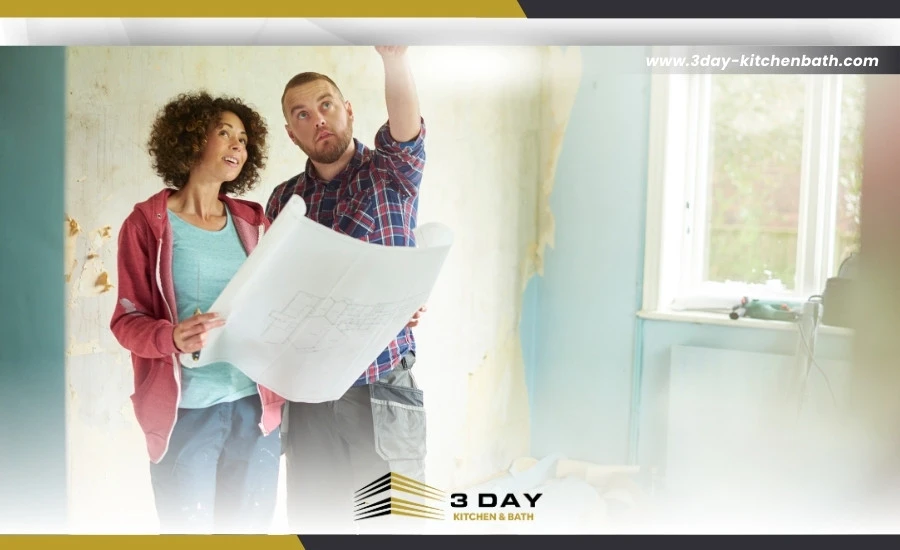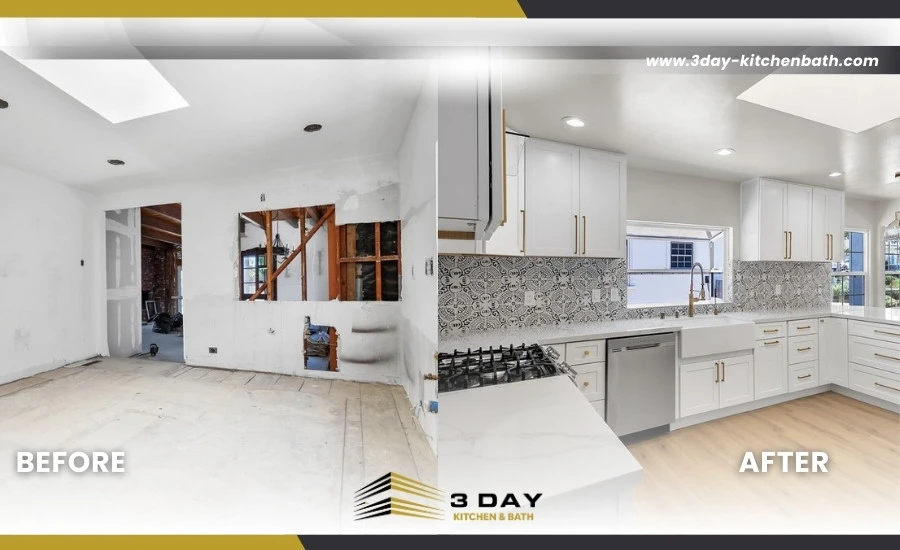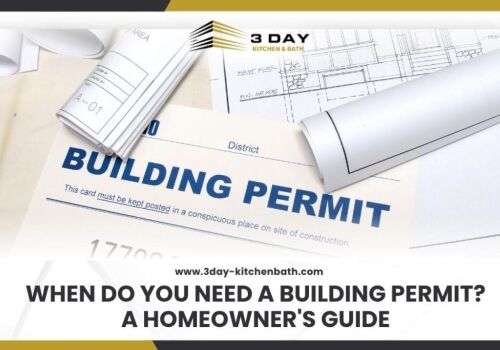Planning a home remodel can feel overwhelming, but breaking it into simple steps makes the process manageable. In this guide on how to plan a home remodel, you'll learn everything from creating your vision to working with home remodeling contractors. Whether you're just starting or already planning a remodel, this step-by-step approach will help you avoid costly mistakes and stay within your budget.
- Step-by-Step Guide to Planning Your Home Remodel
- Step 1: Define Your Remodeling Goals
- Step 2: Set a Realistic Budget
- Step 3: Create a Detailed Plan and Timeline
- Step 4: Hire the Right Professionals
- Step 5: Get Permits and Approvals
- Step 6: Prepare Your Home for the Work
- Step 7: Stay Involved During the Remodel
- Avoid These Common Mistakes When Planning a Remodel
- How Can You Stay on Budget and Still Get What You Want?
- Ready to Start Planning Your Remodel?
- Frequently Asked Questions
- How long does a typical home remodel take?
- Do I need a designer for my home remodel?
- Can I live at home during the remodel?
- What rooms add the most function when remodeled?
- Is it okay to remodel in stages?
Step-by-Step Guide to Planning Your Home Remodel
Remodeling your home takes more than just picking out new paint or fixtures. It requires clear planning, smart budgeting, and the right team to bring your vision to life. Follow these simple steps to take the stress out of the process and feel confident about your remodel from start to finish.
Step 1: Define Your Remodeling Goals
Before picking up a hammer or calling a contractor, take time to think about why you want to remodel. Are you updating a kitchen for better functionality? Adding space for a growing family? Improving the value of your home? Write down your goals and needs for each room. Consider these key questions:
- What do I want to change?
- What isn't working with the current layout or design?
- What would make this space better for daily use?
Being clear about your goals will help you make better decisions throughout the project and communicate clearly with designers or builders.
Step 2: Set a Realistic Budget
Budgeting is one of the most important parts of planning a remodel. It helps guide your decisions and keeps your project from getting out of control. Start by researching typical costs for similar remodels in your area. Then, make a rough list of your remodeling priorities. Break your budget into categories like:
- Labor
- Materials
- Permits
- Design fees
- Unexpected expenses (always set aside at least 10–15% for surprises)
Use simple spreadsheets or budgeting apps to track costs. Knowing your limits will help you stick to what matters most and avoid overspending.
Step 3: Create a Detailed Plan and Timeline
Once you know what you want and how much you can spend, it's time to plan. A remodeling plan includes your design ideas, product choices, and a schedule for each phase. Start by:
- Sketching your layout changes
- Picking materials (flooring, paint, fixtures)
- Gathering ideas from online sources or magazines
You can use free online design tools or work with a designer to finalize plans. Also, create a timeline for when each part of the project should happen. This helps prevent delays and keeps everyone on the same page.
Step 4: Hire the Right Professionals
A successful remodel depends on working with the right people. Do your homework before hiring a contractor, designer, or architect. Ask friends or neighbors for recommendations and check online reviews. When talking to potential contractors:
- Ask for references and photos of past work
- Make sure they are licensed and insured
- Get written estimates and timelines
- Read contracts carefully before signing
Working with an experienced team like 3 Day Kitchen & Bath in San Diego, CA, means you'll get expert help from start to finish. Local pros also understand city codes and permit needs, which can save you time and stress.
Step 5: Get Permits and Approvals
Not all remodels need permits, but many do, especially if you're moving walls, plumbing, or electrical lines. Your contractor can usually help with this step, but it's still good to understand the basics. You may need permits for:
- Room additions
- Structural changes
- Electrical or plumbing updates
- Major kitchen or bath remodels
Check with your local building department early. Starting without the right permits can lead to fines or issues when selling your home later.
Step 6: Prepare Your Home for the Work
Remodeling can be messy and disruptive. Preparing your home ahead of time helps things go more smoothly. Here are a few ways to get ready:
- Move furniture and valuables out of work areas
- Create a temporary kitchen or bathroom if needed
- Make a plan for kids and pets during noisy or unsafe work
- Communicate with neighbors if work might affect them
Keeping your space organized helps workers do their jobs better and helps reduce stress for your household.
Step 7: Stay Involved During the Remodel
Once the work starts, it's tempting to just let the pros handle it all. But staying involved helps catch problems early and keeps things on track.
Check-in regularly with your contractor. Ask for updates and walk through the space often. Don't be afraid to speak up if something doesn't look right or feels off-track.
It's also important to stay flexible. Small issues or delays may come up, but good communication and planning help solve problems quickly.
Avoid These Common Mistakes When Planning a Remodel
Even with a good plan, remodels can go wrong. Being aware of common pitfalls can save you time, money, and frustration. Avoid these mistakes:
- Not Setting a Budget: Guessing costs often leads to overspending.
- Skipping the Planning Stage: Rushing into construction can cause delays and redesigns.
- Hiring the Cheapest Contractor: Price matters, but quality and trust matter more.
- Changing Your Mind Too Much: Frequent changes during construction increase time and costs.
- Not Reading Contracts Carefully: You should understand every part of the agreement.
How Can You Stay on Budget and Still Get What You Want?
Remodeling on a budget doesn't mean cutting corners. It means making smart choices. Here's how to stay within your limits without losing your vision:
- Prioritize Needs Over Wants: Focus spending on must-haves first.
- Reuse Where Possible: Refacing cabinets or keeping layouts can save thousands.
- Shop Smart: Look for sales, discounts, or surplus stores.
- Avoid Scope Creep: Stick to your original plan to avoid added costs.
- Work in Phases: Tackle one room at a time if your budget is tight.
Ready to Start Planning Your Remodel?
Now that you know how to plan a home remodel, you're one step closer to creating the home you've always wanted. From setting goals to avoiding costly mistakes, planning a remodel doesn't have to be stressful.
If you need home remodeling in San Diego, let 3 Day Kitchen & Bath help turn your vision into a beautiful, functional space quickly and professionally. Call us today to schedule your consultation.
Frequently Asked Questions
How long does a typical home remodel take?
The timeline depends on the size and type of remodel, but most projects take several weeks to a few months. Proper planning helps prevent delays and keeps the project moving smoothly.
Do I need a designer for my home remodel?
A designer isn't always required, but they can help you make smart layout choices, pick materials, and avoid design mistakes, especially for kitchen or bathroom remodels.
Can I live at home during the remodel?
In many cases, yes. However, it depends on the scope of the work. For major remodels, parts of your home may be off-limits, so plan for noise, dust, and limited access to certain rooms.
What rooms add the most function when remodeled?
Kitchens and bathrooms typically bring the biggest impact in terms of daily use. Updating these spaces can improve functionality and comfort while enhancing your lifestyle.
Is it okay to remodel in stages?
Yes, remodeling in phases is a smart way to manage time, stress, and budget. Focus on one room at a time, starting with the area that needs the most attention or adds the most value.











